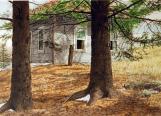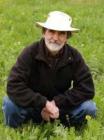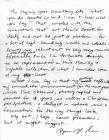1
Bruce St. Clair, the second eldest of five children, was born in 1945 in Galt, Ontario (now part of Cambridge) as Herbert Bruce St. Clair. He was raised in the country near Galt.In 1964, he moved to Toronto, Ontario, where he studied Advertising Design at the Ontario College of Art (now the Ontario College of Art and Design) from 1964 to 1967.
In 1969, he married and moved to Callander, Ontario. He painted works on a tourist camp owned by his parents on the south shore of nearby Lake Nipissing.
In 1987, he moved to Corbeil, Ontario. In 1990, he moved to Callander. In 1993, he remarried. In 1999, he moved to Dunbar, on the southeast coast of Scotland. In 2000, he returned to Callander and then North Bay, Ontario.
Solo exhibitions of his work have been held at: Aggregation Gallery (1969, 1970, 1971, 1972 and 1973, Toronto); Moose Jaw Public Art Museum (1973, Saskatchewan); Aggregation Gallery (1974, Toronto); The Gallery/Stratford (1975, Stratford, Ontario); the London Art Gallery (London, Ontario), Laurentian University (Sudbury, Ontario), Glenbow-Alberta Institute (Calgary, Alberta), The Norman Mackenzie Gallery, Regina, Saskatchewan), The Kitchener-Waterloo Art Gallery (Kitchener, Ontario), Confederation Art Gallery (Charlottetown, PEI), New Brunswick Museum (Saint John) and Aggregation Gallery (Toronto) (1977-78, Bruce St. Clair: Paintings: A Ten Year Survey); Aggregation Gallery (1979, Toronto), MacDonald Stewart Art Centre (1981, Guelph, Ontario), Canadian Embassy (1981, Washington, DC), Aggregation Gallery (1982, Toronto), and Joan Ferneyhough Gallery (North Bay, 1998).
He has done artist residencies at the McDonald Stewart Art Centre (University of Guelph, Guelph, Ontario, 1981) and Canadore College (North Bay, 1986-1987), through which he has taught drawing and painting courses through continuing education from 1987 to the present.
Bruce's works are in public, private and corporate collections, including the Art Gallery of Algoma (Sault Ste. Marie, Ontario), Canadore College (North Bay), CIL (Toronto), Crown Life Insurance Company (Toronto), Goodman & Goodman (Toronto), H. J. Heinz Co. Ltd., Hallmark (Toronto), J. S. Redpath (North Bay), The MacDonald Stewart Art Centre (Guelph, Ontario), MacDonald Tobacco Inc. (Montreal), Mendel Art Gallery (Saskatoon, Saskatchewan), Ministry of Correctional Services (North Bay), Municipality of North Bay , Noranda Mines Ltd. (Toronto), Ontario Northland Transportation Commission (North Bay), Saskatoon Gallery & Conservatory (Saskatoon, Saskatchewan), Transcanada Pipelines (Toronto), and the University of Guelph (Guelph, Ontario).
Bruce's web site can be viewed at http://www.theegallerystclair.ca
(The biographical information featured here was written in consultation with the artist in 2006.)
Interview:
Q: What is your earliest memory of being interested in art?
A: Apart from stories told and early drawings saved (I was always drawing), one of my earliest independent memories comes from kindergarten, where I was recognized as the class artist. A pretty girl asked me to draw a robin for her, which I did, hoping to gain her favour. Unfortunately, she was more interested in my older brother in the next grade. In grades 1 and 2, my teacher set up an easel at the back of the classroom just for me, where I was free to go and paint when my work was finished. Apparently I had a tendency to gaze out the window and daydream.
Q: Have you always wanted to be an artist?
A: I've always been an artist--in terms of doing it. As a profession, I initially tried to avoid it, having come to understand it could not be depended upon for a regular income. So, after taking the interests/career high school evaluation test, which indicated a suitability for working in the great outdoors, as well as in art, I decided to head for the Lands and Forests (now Natural Resources) college at Dorset following grade 13. But when all I managed to pass was French Authors and Grammar, I applied to the Ontario College of Art (which didn't require 13), signing up for Advertising Design. I figured if I became an illustrator, I could make pictures and get paid for it. This was a logical solution...I was, after all, just trying to be responsible, figuring there would likely be a family to look after in my future. Then I flunked the third year, juggling college, a part time job and a girl friend. So much for trying to plan my life. Seems God had other plans for me, and I was just dodging them. So I went home and started painting.
Q: What artist(s), if any, was a big influence to you?
A: Initially, I was drawn to the paintings of Tom Thompson, the Group of Seven (my outdoor thing) and the French Impressionists. This carried over a bit from my high school art. After working construction for the summer, a friend and I bought a canoe between us, and I launched my painting 'career' on a Thompson-esque adventure down the mighty Magnetawan River, birch panels and all. As I was working towards my first one-man-show at Aggregation Gallery in Toronto (1969), I discovered the realism of Andrew Wyeth. Though I enjoyed more 'painterly' work--still do--this 'gave me permission' to follow my natural bent, which had been discouraged by my high school art teacher. I may yet lean the other way again.
Q: Was there a specific person in your life that motivated you to take your art seriously? Who? How?
A: My grandparents lived in the other half of the large old farmhouse where I was raised. My grandfather was an artist, making his living at carpentry until he became a preacher. He sometimes held special services for kids and used his artistic talent to create large, dramatic paintings, each depicting the high point of one of the stories he would relate as teaching illustrations. Of course, the picture was always covered until the dramatic moment in the story arrived, when the sheet would come down and the anticipation was rewarded. The kids were never allowed in the front hall when (and where) he was working on a painting. The fumes from his homemade paint were too strong (lethal?) and I suspect they contributed to his declining health.
My high school art teacher also encouraged me, though he gave up on me when I turned to realism.
Q: What inspires you when working on art?
A: My painting style requires a methodical approach once the painting has been started. The inspiration (which is the visual content and concept itself) comes earlier; then it's just a matter of working to bring it to actuality. If the process gets tedious, which it often does, a distraction like music or the CBC can be a big help. I can look at part of a painting and recall what I was listening to while painting it.
To dig a bit deeper, I would add that my Christian faith and worldview provide direction that is often more by inspiration than intention. Though the content of my paintings can be almost parabolic, I sometimes don't 'get it' till after the fact.
Q: Do you find inspiration from music?
A: Besides being a helpful distraction, music can rouse me, motivate me to keep going (painting), or send me running for my guitar. Music can inspire me--even to worship, its highest virtue--but not usually towards visual art. It touches the musician's soul in me.
Q: Are you the only artist in your family that you know of?
A: My daughter Rosalyn actively pursues her painting, amidst kids and household duties. My youngest sister's three girls each practice a different art form: one (a missionary) paints, the next is following a career in music, and the third, pottery. (My wife Lori is a photographer and musician, but you probably mean my blood relations.) My grandfather used to illustrate Bible stories and my father was a concert level pianist and could also play the violin. In fact many more in the family are musicians than artists other than those mentioned above.
(Interview with Kati Kirke in January, 2007).
3
Bruce St. Clair, Forsaken, watercolour on paper (from W. K. P. Kennedy Gallery permanent collection)n.d.


